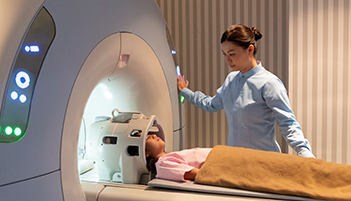HOW CAN WE HELP YOU? Call 1-800-TRY-CHOP
In This Section
Could a Single Brain Scan Predict Autism Among High-risk Infants?

The findings:
A neuroimaging scan at age 6 months may accurately predict autism spectrum disorder (ASD) among high-risk infants. The infants were considered to be at high risk because they had older siblings with ASD. Overall, the study team found 974 functional connections in the 6-month-olds’ brains that were associated with autism-related behaviors. A computer analysis of these neural signals’ patterns allowed researchers to identify with more than 96 percent accuracy which children would go on to be diagnosed with autism by 2 years of age, and which children would not.
Why it matters:
All of the science to date shows that early diagnosis and intervention for ASD is the best way to reduce the severity of symptoms over the course of a lifetime. Until now, however, clinicians haven’t had rigorous ways to diagnose children before the behaviors of ASD emerge, typically between ages 2 and 4. Neuroimaging may be a useful early assessment tool for clinicians to detect brain differences that set in motion developmental processes that yield behavioral symptoms of ASD.
Who conducted the study:
The study’s lead author is Robert Emerson, PhD, of the University of North Carolina at Chapel Hill, who is an investigator with the multisite Infant Brain Imaging Study (IBIS) network, which includes the Center for Autism Research at Children’s Hospital of Philadelphia.
How they did it:
The research team used functional connectivity magnetic resonance imaging (fcMRI), which is a safe brain imaging procedure, to look at how regions of the infants’ brains work together during different tasks and during rest. They then applied a computer algorithm—called machine learning — to analyze this brain activity across tens of thousands of neural signals and then to separate the neuroimaging results into two groups — ASD or non-ASD. This method correctly identified nine out of 11 infants who were diagnosed with ASD by age 2, and it correctly identified all of the infants who did not develop autism.
Quick thoughts:
“This is an astounding observation that could fundamentally change clinical practice,” said Robert T. Schultz, PhD, who leads the CHOP research site. “The ability to detect who will develop autism before there are any clear outward manifestations should enable earlier diagnoses and better long-term outcomes for scores of children who develop autism.”
What’s next:
If future studies confirm these results, researchers are encouraged that this growing body of research will mean that in the future, a single brain scan at age 6 months may enable physicians to diagnoses and treat autism earlier than they do today.
Where the study was published:
The study appeared in Science Translational Medicine.
Who helped fund the study:
The Eunice Kennedy Shriver National Institute of Child Health and Human Development and the National Institute of Mental Health funded the study.
Where to learn more:
The study is the fourth in a series of findings published this year by IBIS researchers. Read a feature story in Bench to Bedside for more details about the previous studies. Also see a press release about the current study issued by the National Institutes of Health.


